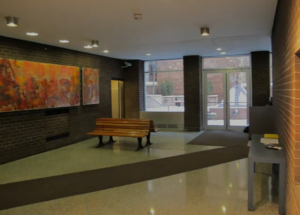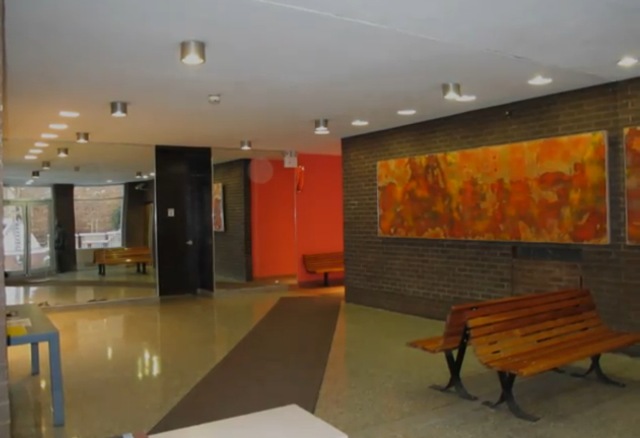Paul Hultberg’s murals are excellent examples of American art in the 20th century. No longer tied to the traditions of jewelry and the small and precious. He has brought enameling into the age of abstract expressionism using glass and the glow of copper as his medium of expression.

Columbus Park lobby mural, NYC
He was not immediately an enamellist, but always interested in murals, first having a mural business in plastics in California. He learned mural techniques in the workshop of Jose Gutierrez in Mexico City, that country is so well known for its murals. Gutierrez was interested in new media that would withstand the elements and introduced Hultberg to vinyl acetate resins, cellulose nitrate resins and silicon-ester. Then he found enameling.
Since he was working on pieces to be used out-of-doors, he did not want the shine of glass and in his first years, work enamels as mat surfaces. Later he added the subtlety of transparents. Working with 28-gauge copper instead of the more usual heavier gauges, he found it reduced warpage more easily.
While teaching painting and drawing and design at the Brooklyn museum, he approached enameling like a print maker, scratching the plate, using wax resists and all kinds of texturing. He liked the fact that enamels forced him to complete something quickly.
After the Brooklyn Museum School teaching stint, Hultberg made numerous commercial enamels for three years. In 1956 he and his wife and children moved to Rockland County as members of the Gate Hill Cooperative near Stony Point, New York where craftsmen David Weinrib, Karen Karnes and M.C. Richards were living and working. His studio was the lower floor of his house which was designed by coop architect Paul Williams. He had two kilns, a long firing bed of his own design for large panels that under which ran a cart to hold then work. Williams then commissioned an enamel mural of the outside of his workshop!
He works from the intention of the size and how to break up the space. He starts by making a number of drawings, feeling out the forms. Then he does color samples, handling the forms in color to scale model enamels. By applying all elements of his design in the first firing, the second one may involve only an over-all color or clear glaze.

Columbus Park lobby mural, NYC
In an article by his friend and coop worker, M.C. Richards describes Hultberg’s procedure: 1) Cuts a clean piece of copper with a paper cutter, rolls it flat, cleans it with steel wool. 2) Brushes on design with glycerine and water, which tends to roll and skip on the somewhat oily metal surface; brushes the mixture to which a commercial binder has been added. Applies the enamel shaken with a tea strainer and then dusted off. The enamel sticks to the brushed strokes. 3) Bare areas are sometimes brushed with a mixture of vinegar and salt, which influences the oxidation occurring during the firing. 4) Lays panel on metal rods of firing bed. Lights torches, passed flames under panel producing re heat, moving flames back and forth thereby producing oxidation patterns on bare metal. 5) Removes panel from bed and rolls it flat as oxidation pops off and is brushed away, leaving marble image in black, reds and rusts, vivacity of metal on which thick white glass floats. 6) Applies wax, which slightly darkens the panel. Often with age and exposure, the naked copper may further darken and become green like bronze, and effect that Hultberg likes.
Spontaneity is both evident in his way of working and in the freshness of the result. Those who have visited his studio are also impressed with the number works he discards as not all met with acceptance from the artist’s eye.
——————
Source: Excerpted from an article titled, Pioneers of Enamel in the U.S.A. by Vivian Kline published in Glass on Metal: The Enamelist’s Magazine; Volume 16, No.3, August 1997
Images: Columbus Park lobby, Manhattan, NY (not published with the original article)